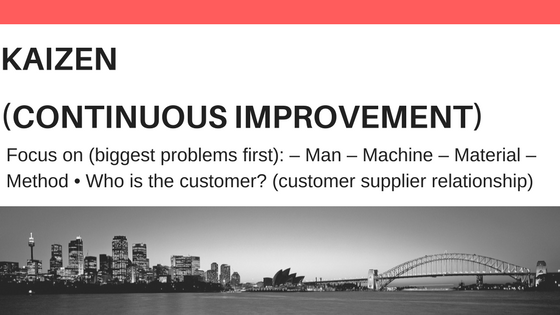Lean Kaizen (continuous improvement), Systems Thinking & Process Variability
Resource: Kaizen (continuous improvement), Systems Thinking and Lean, Process Variability
Kaizen (continuous improvement)
• Kaizen activities become part of the standards
• Focus on (biggest problems first):
– Man
– Machine
– Material
– Method
• Who is the customer? (customer supplier relationship)
• Lean transference to the supply chain
• To be lean is to do more with less resources
Systems Thinking and Lean
• Systems are made up of integrated series of processes/parts each with a clearly defined goal
• Systems change over time
• By nature we are programmed to react to immediate threats not to think and react to slowing moving threats to the system
– Continuous improvement helps over come this
• From the systems view point we should be able to identify the individual processes, however from a process view we can’t clearly understand the system
– All the trees get in the way of seeing the forest
Process Variability
• There are basically only two ways an organization can take away from their bottom line. The first is lack of capital goods, which is the easier of the two to solve.
– This can be lack of: tools, people, methods, supplies, infrastructure, space, knowledge, etc.
– Generally the organization can put together a business plan to solve the first, but the second is much harder to see even though it is typically in front of you all of the time.
• Variability is the second way to take away your profits, it is truly a form of waste (muda).
– It is the more hidden of the two methods and typically present in almost every process in our operating system, as we have observed.
• Kaizen activities become part of the standards
• Focus on (biggest problems first):
– Man
– Machine
– Material
– Method
• Who is the customer? (customer supplier relationship)
• Lean transference to the supply chain
• To be lean is to do more with less resources
Systems Thinking and Lean
• Systems are made up of integrated series of processes/parts each with a clearly defined goal
• Systems change over time
• By nature we are programmed to react to immediate threats not to think and react to slowing moving threats to the system
– Continuous improvement helps over come this
• From the systems view point we should be able to identify the individual processes, however from a process view we can’t clearly understand the system
– All the trees get in the way of seeing the forest
Process Variability
• There are basically only two ways an organization can take away from their bottom line. The first is lack of capital goods, which is the easier of the two to solve.
– This can be lack of: tools, people, methods, supplies, infrastructure, space, knowledge, etc.
– Generally the organization can put together a business plan to solve the first, but the second is much harder to see even though it is typically in front of you all of the time.
• Variability is the second way to take away your profits, it is truly a form of waste (muda).
– It is the more hidden of the two methods and typically present in almost every process in our operating system, as we have observed.
